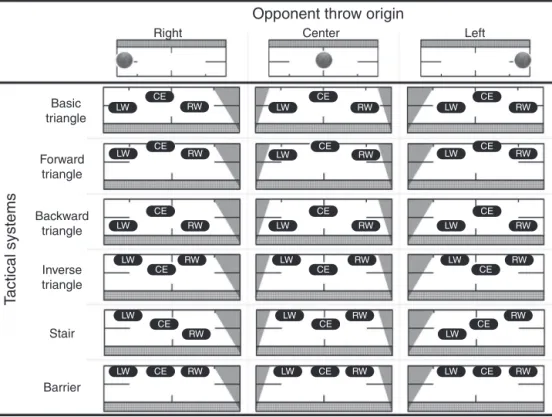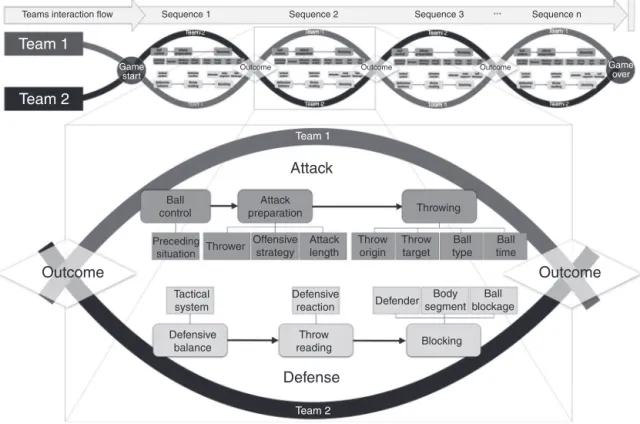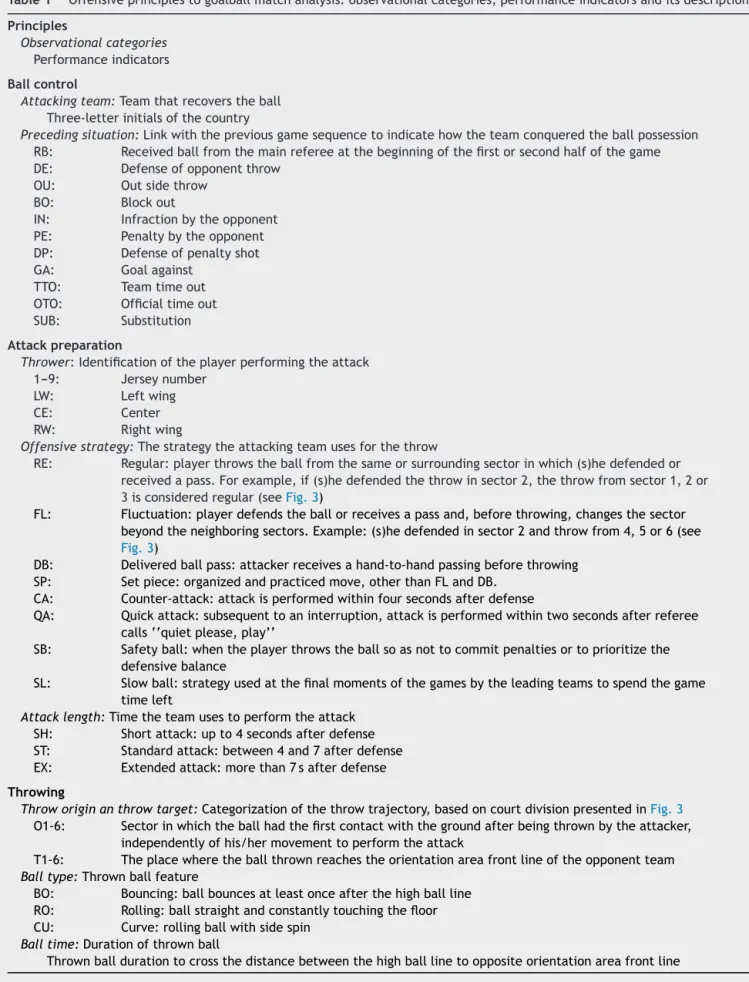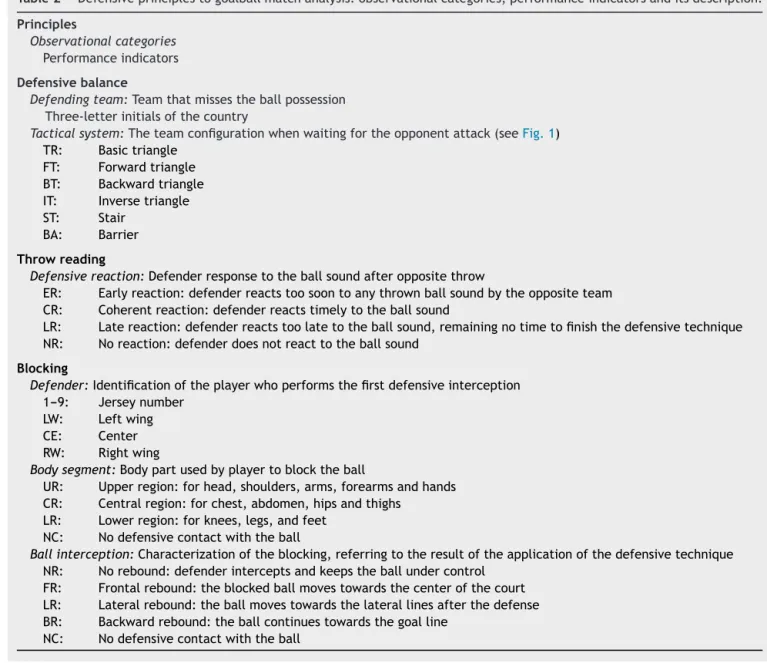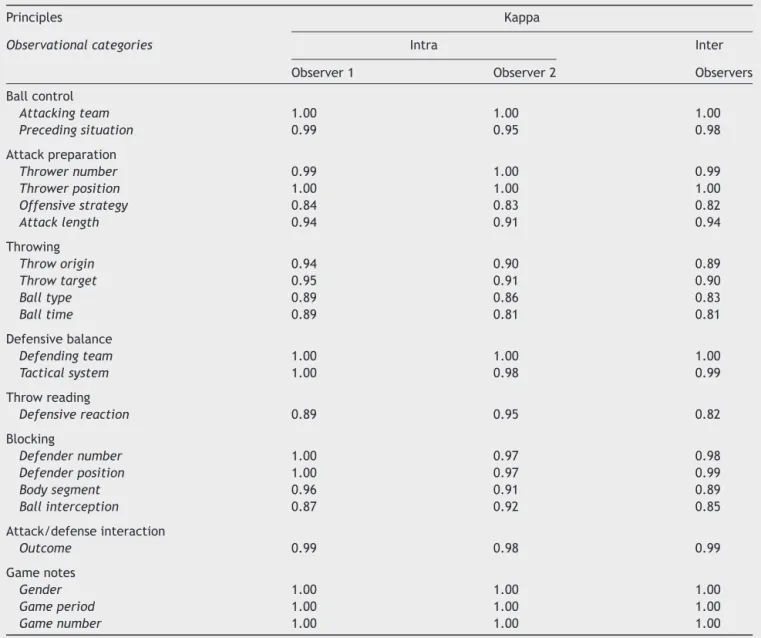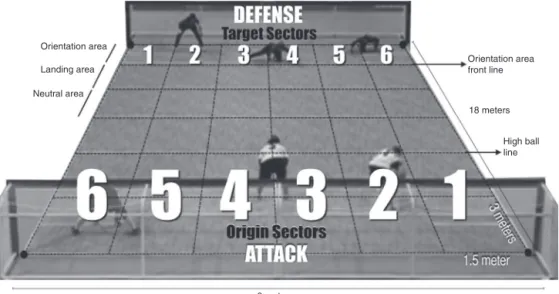www.rbceonline.org.br
Revista
Brasileira
de
CIÊNCIAS
DO
ESPORTE
ORIGINAL
ARTICLE
Development
and
evaluation
of
an
observational
system
for
goalball
match
analysis
Márcio
Pereira
Morato
a,∗,
Otávio
Luis
Piva
da
Cunha
Furtado
b,
Diego
Henrique
Gamero
b,
Thiago
Pinguelli
Magalhães
b,
José
Júlio
Gavião
de
Almeida
baUniversidadedeSãoPaulo,EscoladeEducac¸ãoFísicaeEsportedeRibeirãoPreto(EEFERP-USP),RibeirãoPreto,SP,Brazil bUniversidadeEstadualdeCampinas,FaculdadedeEducac¸ãoFísica(FEF-Unicamp),Campinas,SP,Brazil
Received1April2016;accepted9August2016
Availableonline13September2016
KEYWORDS
Performance indicators;
Sportperformance; Paralympicteam sports;
Visualimpairment
Abstract Ourpurposewastodevelopandevaluateanobservationalsystemforgoalballmatch analysis.Weusedanon-participantsystematicgameobservationmethodincludingeightelite games,videorecorded,andrandomlychosen.Observationalcategoriesandperformance indi-catorsweredeterminedforeachoffensive(i.e.,ballcontrol,attackpreparation,andthrowing) anddefensiveprinciples(i.e.,defensivebalance,throwreading,andblocking).The compre-hensivemethodofdevelopmentandtheidealreliabilitylevels(kappacoefficientof0.81---1.00) ofthisprotocolensurethegenerationofquantitativeandqualitativeinformationforplayers andcoachesandtherigorrequiredforscientificuse.
©2017Col´egioBrasileirodeCiˆenciasdoEsporte.PublishedbyElsevierEditoraLtda.Thisisan openaccessarticleundertheCCBY-NC-NDlicense( http://creativecommons.org/licenses/by-nc-nd/4.0/).
PALAVRAS-CHAVE
Indicadoresde performance; Desempenho esportivo; Esportecoletivo paralímpico; Deficiênciavisual
Desenvolvimentoeavaliac¸ãodeumsistemadeobservac¸ãoparaanálisedojogo degoalball
Resumo Nossoobjetivofoidesenvolvereavaliarumsistemadeobservac¸ãoparaanálisedo jogonogoalball.Foiusadoummétododeobservac¸ãosistemáticanãoparticipante,incluindo vídeos de oito jogos de elite escolhidosaleatoriamente. Categorias de observac¸ão e indi-cadoresdedesempenho foramdeterminadasparacadaprincípioofensivo (i.e.,controlede bola,preparac¸ãodoataqueeefetivac¸ãodoarremesso)edefensivo(i.e.,balanc¸odefensivo, leituradatrajetóriaeinterceptac¸ãodoarremesso).Oabrangentemétododedesenvolvimento
∗Correspondingauthor.
E-mail:mpmorato@usp.br(M.P.Morato).
http://dx.doi.org/10.1016/j.rbce.2016.08.002
eosníveisdeconfiabilidadeideais(coeficientekappade0,81-1,00)desseprotocoloasseguram agerac¸ãodeinformac¸õesquantitativasequalitativas parajogadoresetreinadoreseorigor necessárioparausocientífico.
©2017Col´egioBrasileirodeCiˆenciasdoEsporte.PublicadoporElsevierEditoraLtda.Este ´e umartigoOpenAccesssobumalicenc¸aCCBY-NC-ND(http://creativecommons.org/licenses/ by-nc-nd/4.0/).
PALABRASCLAVE
Indicadoresde rendimiento; Rendimiento deportivo; Deportedeequipo paralímpico; Deficienciavisual
Desarrolloyevaluacióndeunsistemadeobservaciónparaelanálisisdeljuego
delgoalball
Resumen Nuestroobjetivofuedesarrollaryevaluarunsistemadeobservaciónparaelanálisis deljuegodelgoalball.Seutilizóunmétododeobservaciónsistemáticanoparticipante,que incluíavídeosdeochojuegosdeéliteelegidosalazar.Sedeterminaronlascategoríasde obser-vaciónylosindicadoresderendimientodecadaprincipioofensivo(p.ej.,controldelbalón, preparacióndelataqueylanzamiento)ydefensivo(p.ej.,equilibriodefensivo,lecturadela trayectoriaeinterceptacióndellanzamiento).Elmétodocompletodeldesarrolloylos nive-lesdefiabilidadideales(coeficientekappade0,81a1,00)delpresenteprotocoloaseguranla generacióndeinformacióncuantitativaycualitativaparajugadoresyentrenadores,yelrigor necesarioparaelusocientífico.
©2017Col´egioBrasileirodeCiˆenciasdoEsporte.PublicadoporElsevierEditoraLtda.Estees unart´ıculoOpenAccessbajolalicenciaCCBY-NC-ND(http://creativecommons.org/licenses/ by-nc-nd/4.0/).
Introduction
Inthecontextofteamsports,researchershaveassumedits inherentcomplexityandinstability,acknowledgingthemas systemsand broadenedthe researchfocustothelogic of thegameanditspatterns(Bar-Yam,2003;McGarryetal., 2002;ReedandHughes,2006;Travassosetal.,2013).This trendpresupposes the creationof modelsable to charac-terize:therelationbetweenthequantitiesandqualitiesof thegameactions,theorganizationofthegame,thetypes of sequences that generate positive or negative results, thescenariosor geometryofthegameintheevolutionof teamsinspaceandtime,theinteractionsorco-adaptation betweenattackersanddefenders(BarrisandButton,2008; Duarteetal.,2012;McGarry,2009;Passosetal.,2013;Vilar etal.,2012).
Research regarding Paralympic team sports, still in its embryonicstage,hasnotconsistentlyaddressedthistrend ofmatchanalysistoadaptedsports,suchaswheelchair bas-ketball(Gómezetal.,2014;Wangetal.,2005),icesledge hockey(Moliketal.,2012),andalsogoalball(Amorimetal., 2010;Mora,1993).Goalballisanon-territorialinvasionteam sportcreatedexclusivelyforpeoplewithvisualimpairment, whichisbasedonhearing(ballwithbellsinside)andtactile (raisedlines)clues.Inthissport,twoteamwiththree ath-leteseachstaypositionedintheoppositeendsidesofacourt with dimension similar toa volleyball court (18m×9m),
dividedintotwohalvesbyacenterline.Fromarestricted area,theattackingteamthrowsaballalongthefloortoward the opponent’s goal. The defending team, positioned in an area with tactile markings, tries to block the thrown ball, usually by sliding on the floor (Gulick and Malone, 2011).
Assuming thecomplexity of teamsports, Moratoetal. (2012)identifiedtheself-organizingcycleofgoalballteams byusingsystematicvideoobservationofan elite competi-tion.Theseauthorspresentedthreeprincipleseachinthe offensive (ball control, attack preparation and throwing) anddefensive(defensivebalance,throwreadingand block-ing)dimensions.WhileTeam1attemptstocontroltheball afterinterceptingthethrowbyTeam2,thelatterassumes adefensivebalance,thatis, theteamreturnstoits tacti-calsystemand isattracted bythe originof theopponent throwtoreconfigureitself,whilemovingasablockto ratio-nallyoccupythecourt(Fig.1).AsTeam1controlstheball, itcontinuespreparingitsattackinordertothrowtheball. Team2isstillfocusingonthedefensivebalanceprinciple, changingthefocustoreadthethrowassoonastheTeam 1 thrower starts the run-up tothrow the ball. When the attackerreleasestheball,Team2willinterpretthethrow, definingitstrajectoryandcategorizingitundertime pres-sureinordertointerceptit effectively.Afterintercepting thethrow,Team2controlstheballandpreparesthenext attackwhileTeam1movesfromtheoffensivetothe defen-sive dimension,focusing onthe defensive principlesuntil thethrownballisrecovered(seeVideo1).
Thus,agamesequenceincludesoneteam’sconfiguration tocomplywiththeoffensiveprinciples,theconfigurationof theopponentteamtocomplywiththedefensiveprinciples inresponsetotheotherteam’sattack,andtheoutcomeof thisinteraction.Thesetofgamesequencesrepresentsthe goalballgame,meaningthehistoryofrelationsbetweenthe teams’oppositedimensions(Moratoetal.,2012).
Opponent throw origin
T
a
ctical systems
Right
Basic triangle
Forward triangle
Backward triangle
Inverse triangle
Stair
Barrier
Center Left
LW CE
RW
LW
LW
LW
LW
LW CE
CE
CE
CE
CE RW
RW LW
CE RW
RW LW
CE RW
RW
LW
LW LW LW LW LW
LW LW
CE CE
CE CE CE CE
CE CE
RW RW
RW RW RW RW
RW RW
RW LW CE RW LW CE RW
Figure1 Rationalcourtoccupationindifferenttacticalsystems.Whiteareasrepresentspacestobeoccupied,andgrayareas
representlessdangerousareasforeachopponentthroworigin.Legend:LW,leftwing;CE,central;RW,rightwing.Adaptedfrom
Moratoetal.(2012).
Methods
In this study,we useda non-participant systematic game observationmethod(Anguera,1999;Thomasetal.,2011). Some basic principles should befollowed in thismethod: elaborating an ad hoc instrument to record the cate-gories and indicators that are considered fundamental in thetheoreticalandspecificpracticalframework,preparing expertobservers,preservingthespontaneityofthesystem observed,focusingontheactual game/competition situa-tion,andmaintainingthetemporalcontinuity,sothatthe patternscanbefoundamidstchangeableandrandom behav-iors(AngueraandHernández-Mendo,2014).Thestudywas conductedaccordingtotheDeclarationofHelsinkiandthe researchprojectwasreviewedandapprovedwithno restric-tionsbyaninstitutionalethicscommittee.
Goalballmatchanalysisinstrumentelaboration
Theobservational system isa basic matchanalysis instru-ment.Theobservershouldelaborateitbasedonthereality distinguishedin hisconception of the game and the the-oreticalframeworkthisreality isbased on,attempting to answer questions about: who, when, where and how the actions are executed (Hughes and Bartlett, 2002; Wright etal.,2014).Thecategoriesformulatedshouldbe exhaus-tive(needtoclassifyallactionsofthegame)andmutually exclusive (each action should refer to only one of the indicators per category) (Anguera and Hernández-Mendo, 2014).
Therefore, Anguera and Hernández-Mendo (2013) con-sider thatitis fundamental todedicategreattimetothe creation,reformulation andestablishment ofeach model, withaviewtocoveringthefullspectrumofconstraintsthe observerconsidersfundamental.Theseauthorssuggest non-systematic,exploratoryobservationsessionsbeforestarting asystematicstudy,aimingtodelimittheresearchproblem; elaboratingtheadhocinstrument;trainingoftheobservers toreduce theoccurrence of future errors;and collecting information for decision making about the research plan-ning.
Inthatsense,departingfromtheconceptionofthe goal-ball game proposed by Morato et al. (2012), the three offensive (ball control, attack preparation and throwing) and three defensive principles (defensive balance, throw readingandblocking)wereadoptedasthestructuralcriteria ofourobservationalsystem.Therefore,weobservedeight goalball games video recordedand randomlychosen from theIBSAWorldGames2007.
While observing the games, an open listof team con-ductswaselaboratedwhileperformingeachprinciple.Each principle was observed exhaustively, that is, until per-ceiving that all possible situations that represented the performanceindicatorshadbeenlisted.Afterobservingone principle, the nextwas observed until obtaining a list of events for eachof thesixprinciples.Withthelistof per-formanceindicatorsforeachprincipleinhand,athematic grouping processwasstarted, representing the identifica-tionoftheobservationalcategories.
Teams interaction flow Sequence 1
Outcome
Outcome
Outcome
Ball control
Preceding situation Thrower
Offensive strategy
Attack length
Throw origin
Throw target
Ball type
Ball time
Defensive reaction
Defensive balance
Throw
reading Blocking
Tactical
system Defender
Body segment
Ball blockage Attack
preparation
Attack
Defense
Throwing
Outcome Outcome
Sequence 2 Sequence 3 Sequence n
Team 1
Team 2
Team 1
Team 2
Team 2
Team 2 Team 1
Team 1 Team 2
Game start
Game over
Team 1
Team 2
Figure2 Thegraphicrepresentationofagoalballgame.Theupperpartdisplaysamacro-viewofagoalballgamerepresented
bytheteamsinteraction.Thelowerpartpresentsonegamesequenceandtheproposedobservationalcategoriesoftheoffensive
anddefensiveprinciples.
performance indicators, to four experienced coaches (all havingatleast6yearsofcoachingclubteams;twoofthem coachingnationalteams).Performanceindicatorswere dis-cussedandtheselecteditemswereincludedintheprotocol. Following, clear operational definitions were established and agreed upon by the coaches involved in the process (Wrightetal.,2014).
Reliabilityassessment
Two expert observers (more than 2 years of experience as referees and goalball coaches) went through a learn-ing process of the instrument. Initially, they received a protocol with the observational categories andtheir per-formanceindicators.Next,twosupervisedtrainingsessions were performed on different days for the identification of the differentindicators per categories in the recorded imagesandthepracticalapplicationofthedatarecording bycompletingtheadhocinstrument,elaboratedinan elec-tronicworksheet. As doubts emergedduring the training, theobserversreturnedtotheprotocoltoreachaconsensus. Thetrainingterminatedaftersolvingthedoubts.
Afterthetraining,theobserversstartedthevideo anal-ysis of two randomly selected goalball games from the Beijing 2008 Paralympic Games. This represented a sam-ple of 314 game sequences (attack/defense/results). The second observationof thegamestookplace15 daysafter theendofthefirst.Wecalculatedtheinterandintra-rater reliabilitybyusingCohen’sKappacoefficient(Fleissetal., 2013).
Results
InFig.2,weshowthegraphicrepresentationofagoalball game.This modelresultsfromthe systematicobservation processof the offensive (ball control, attack preparation andthrowing)anddefensiveprinciples(defensivebalance, throwreadingandblocking)ofgoalball.
Basedonthisgoalballgamemodel,atleastone observa-tionalcategorywiththerespectiveperformanceindicators wasobtainedforeachprinciple(seeTables1---3).
Thereliability(Kappa)coefficientsoftheproposedmodel arepresentedinTable4.
Discussion
Table1 Offensiveprinciplestogoalballmatchanalysis:observationalcategories,performanceindicatorsanditsdescription.
Principles
Observationalcategories
Performanceindicators
Ballcontrol
Attackingteam:Teamthatrecoverstheball Three-letterinitialsofthecountry
Precedingsituation:Linkwiththepreviousgamesequencetoindicatehowtheteamconqueredtheballpossession RB: Receivedballfromthemainrefereeatthebeginningofthefirstorsecondhalfofthegame DE: Defenseofopponentthrow
OU: Outsidethrow BO: Blockout
IN: Infractionbytheopponent PE: Penaltybytheopponent DP: Defenseofpenaltyshot GA: Goalagainst
TTO: Teamtimeout OTO: Officialtimeout SUB: Substitution
Attackpreparation
Thrower:Identificationoftheplayerperformingtheattack 1---9: Jerseynumber
LW: Leftwing
CE: Center
RW: Rightwing
Offensivestrategy:Thestrategytheattackingteamusesforthethrow
RE: Regular:playerthrowstheballfromthesameorsurroundingsectorinwhich(s)hedefendedor receivedapass.Forexample,if(s)hedefendedthethrowinsector2,thethrowfromsector1,2or 3isconsideredregular(seeFig.3)
FL: Fluctuation:playerdefendstheballorreceivesapassand,beforethrowing,changesthesector
beyondtheneighboringsectors.Example:(s)hedefendedinsector2andthrowfrom4,5or6(see
Fig.3)
DB: Deliveredballpass:attackerreceivesahand-to-handpassingbeforethrowing
SP: Setpiece:organizedandpracticedmove,otherthanFLandDB.
CA: Counter-attack:attackisperformedwithinfoursecondsafterdefense
QA: Quickattack:subsequenttoaninterruption,attackisperformedwithintwosecondsafterreferee
calls‘‘quietplease,play’’
SB: Safetyball:whentheplayerthrowstheballsoasnottocommitpenaltiesortoprioritizethe
defensivebalance
SL: Slowball:strategyusedatthefinalmomentsofthegamesbytheleadingteamstospendthegame
timeleft
Attacklength:Timetheteamusestoperformtheattack
SH: Shortattack:upto4secondsafterdefense
ST: Standardattack:between4and7afterdefense
EX: Extendedattack:morethan7safterdefense
Throwing
Throworiginanthrowtarget:Categorizationofthethrowtrajectory,basedoncourtdivisionpresentedinFig.3
O1-6: Sectorinwhichtheballhadthefirstcontactwiththegroundafterbeingthrownbytheattacker,
independentlyofhis/hermovementtoperformtheattack
T1-6: Theplacewheretheballthrownreachestheorientationareafrontlineoftheopponentteam
Balltype:Thrownballfeature
BO: Bouncing:ballbouncesatleastonceafterthehighballline
RO: Rolling:ballstraightandconstantlytouchingthefloor
CU: Curve:rollingballwithsidespin
Balltime:Durationofthrownball
Table2 Defensiveprinciplestogoalballmatchanalysis:observationalcategories,performanceindicatorsanditsdescription.
Principles
Observationalcategories
Performanceindicators
Defensivebalance
Defendingteam:Teamthatmissestheballpossession Three-letterinitialsofthecountry
Tacticalsystem:Theteamconfigurationwhenwaitingfortheopponentattack(seeFig.1)
TR: Basictriangle
FT: Forwardtriangle
BT: Backwardtriangle
IT: Inversetriangle
ST: Stair
BA: Barrier
Throwreading
Defensivereaction:Defenderresponsetotheballsoundafteroppositethrow
ER: Earlyreaction:defenderreactstoosoontoanythrownballsoundbytheoppositeteam
CR: Coherentreaction:defenderreactstimelytotheballsound
LR: Latereaction:defenderreactstoolatetotheballsound,remainingnotimetofinishthedefensivetechnique
NR: Noreaction:defenderdoesnotreacttotheballsound
Blocking
Defender:Identificationoftheplayerwhoperformsthefirstdefensiveinterception
1---9: Jerseynumber
LW: Leftwing
CE: Center
RW: Rightwing
Bodysegment:Bodypartusedbyplayertoblocktheball
UR: Upperregion:forhead,shoulders,arms,forearmsandhands
CR: Centralregion:forchest,abdomen,hipsandthighs
LR: Lowerregion:forknees,legs,andfeet
NC: Nodefensivecontactwiththeball
Ballinterception:Characterizationoftheblocking,referringtotheresultoftheapplicationofthedefensivetechnique
NR: Norebound:defenderinterceptsandkeepstheballundercontrol
FR: Frontalrebound:theblockedballmovestowardsthecenterofthecourt
LR: Lateralrebound:theballmovestowardsthelaterallinesafterthedefense
BR: Backwardrebound:theballcontinuestowardsthegoalline
NC: Nodefensivecontactwiththeball
The use of this observational system to deal with performance analysis in goalball can help to evolve the base knowledge on technical and tactical aspects of this particularsport.Thismethodisaninexpensivewayof pro-vidingquantitativeandqualitativefeedbacktoplayersand coachesofhowindividualplayers caninfluenceteam pat-terns(Barris andButton,2008;HughesandBartlett,2002; Vilaretal.,2012).Uptonow,therehavebeenonlyafew studiestryingtocharacterize particularsituationsof goal-ball(Amorimetal.,2010;Mora,1993).Ourmodelexpands onthe theme, proposingmeans to assessall the key ele-mentsoccurringinmaleandfemaleelitegoalballgames.We believetheinteractivewaytheinstrumentwascreated,by gatheringfeedbackthroughconstantexchangeofideaswith elitecoaches,ledustocomprehensivelydeterminewhich werethemostrelevantoffensive(howtheballiscontrolled; howtheattackisprepared;andhowthethrowisperformed) anddefensive(howtheteamispositionedonthecourt;how theathletesreactedtotheopponent’sthrow;andhowthe ballisblocked)aspectsofthegame.
Offensiveprinciples
The opponent’s throwingoutcome is the starting point to theballcontrolprinciple.Fromourexperience,this offen-siveprincipleismostcommonlynotedasadefenseofthe opponent’sthrow, asa ball controlledafter a rebound or astheballreceivedfromthereferee.Differentpreceding situationswillinfluencetheoffensivestrategychoiceinthe followingprinciple(attackpreparation).Forexample,aball controlledwithout arebound ortheonegivenby the ref-ereeafteraballoutwillallowlesstimepressuretobuild theattackwithinthetensecondsofballpossessionateam hastoattack.Ontheotherhand,theballcontrolledafter alongreboundorgivenbytherefereeafterablockoutwill reducetheavailabletimetothethrowing,hencereducing thepossibleoffensivestrategies.
Table 3 Attack/defense interaction and game notes to goalball match analysis: observational categories, perfor-manceindicatorsanditsdescription.
Principles
Observationalcategories
Performanceindicators
Attack/defenseinteraction
Outcome:Resultoftheinteractionbetweenthe offensivedimensionofoneteamandthedefensive dimensionoftheother
DE:Defendingteamblockstheballwhich remainsinsidetheirhalfcourt BO: Ballpassesthelimitsofthecourtafter
beingblockedbythedefenders
OU:Ballthrownoutwithoutcontactwiththe defenders
IN: Aninfractionoccurs PE:Apenaltyoccurs GO:Attackingteamscores
PD:Defenderblocksthepenaltyshot PO: Attackerthrowsthepenaltyshotoutside PP:Throwercommitsapenaltyinapenalty
shot
PG: Penaltyshooterscores
Gamenotes:observationsforreferencesofeachgame sequence
Gender
F: Female M: Male
Gameperiod
1: Firsthalf 2: Secondhalf
Gamenumber
Accordingtothelistofgamesobserved
relevant informationfor training specificity. Forinstance, basedoneightgamesfromtheBarcelona1992Paralympic Games,Mora(1993)showedthatwingplayerstendtoattack morefrequentlythancenters.Althoughthisisanimportant informationofthegamepatterns,theauthordidnottake intoconsiderationtheteams’tacticalsystems.Theathletes’ role and their spatial occupation oncourt is likely tobe determinedby thetactical system adopted byeach team (Moratoetal.,2012),whichmayfurtherinfluencethe fre-quencyof attacks perplayers. When assessing the attack lengthonemayfindwhethershorterorlongerattacksare moreeffectiveunderdifferentscenarios.Wealsobelieveit isveryimportanttoidentifyhowdifferentoffensive strate-gies(i.e.,regular,fluctuation,deliveredballpass,setpiece, counter-attack,quickattack,safetyball,orslowball) influ-encethedefensivebalanceof thedefendingteamandits respectiveoutcome.
Throwing,asthelastattackprinciple,isthoughtto char-acterizehowthethrowisperformedinagoalballgame.The efficacyofball typeandball timecan bedeterminedand itsrelation tothrow originand throw targetcan laterbe established.Inpracticalterms,theinitialapplicationofour protocolallowedustoinvestigatetheincidenceof differ-entballtypesandtheoriginandtargetthrowsinelitelevel
goalball. Among the identifiedthreetypes of ball seen in goalball (rolling, bouncing,and curve) we found that the rollingballsweremorecommoninfemaleswhencompared tomalesandthattherollingandbouncingballsweremore frequent than the curves balls for both genders (Morato etal.,2014).Inanotherstudy,wedetected higher occur-rence of throws from the wing sectors in both genders, similar to Amorim et al. (2010), and higher incidence of balls arrivingat the central sectorsof theopposing team area(Moratoetal.,2013).
Defensiveprinciples
For the first defensive principle, defensive balance, we soughttoidentifyhowtheteamispositionedonthecourt (tactical system). The possible identification of throwing patterns, asdiscussed intheoffensive principle,can con-tributetotheteams’organizationtoeffectivelycomplywith thedefensivebalanceprincipleconcept,movingasablock towardtheopponent’sthroworigin(Moratoetal.,2012).In addition,differencesinthedefensivetacticalsystems effec-tivenesscanbeidentifiedwithregardtotherationalspace occupation(seeFig.1).
Besides the spatial issue, the model also enables the recognition ofrhythms inherent tothegame. Inthis way, intheseconddefensiveprinciple(throwreading)thefocus wastounderstandhowathletesreactedtotheopponent’s throwing (defensivereaction). According totheobservers whotookpartinthereliabilitytestingstageofthestudy,the subjectivitymayplaysomeroleinthisprinciplewhenone triestonoteanearly,coherentorlatedefender’sreaction toblocktheball.However,althoughamongthelowest val-uesofinter-raterreliability,agoodlevelofagreementwas achieved(Kappa0.82).Ingoalball,asthedefenders iden-tifytheopponent’sthrowtrajectoryunderatimepressure condition(Moratoetal.,2012),itisrelevanttounderstand ifdifferentrangesofattackballpossessionorthrowingball timeinterfere in thedefensive efficacy, asseem inother sports(Freestonetal.,2014;Wagneretal.,2012).
For the last defensive principle, blocking, our model permits to understand how the ball is blocked (defender number, defenderposition,body segment,and ball inter-ception).Traditionally,goalball teamsassumea triangular positioning,inwhichthecenter,moreadvancedoncourt, playtheprincipalroleof defending,while wingshave the mainroleofattacking(Moratoetal.,2012).However,this maynotbetruefortheallofthepossibledefensive tacti-calsystems,asproposedinFig.1.Anotherrelevantissueof investigationreferstowhichbodysegmentismoreandless efficienttoblockthe ball. Fromourexperience,itseems reasonablethatdefendingtheballwiththebody extremi-tiesmaybelesseffectivetosecurelycontroltheballthan defendingitwiththetrunk,hipandthigh,andtheuse of protocolcanhelptotestthishypothesis.
Possibleinteractionsbetweentheprinciples
Table4 Intraandinter-raterreliabilityofthegoalballobservationalcategories.
Principles Kappa
Observationalcategories Intra Inter
Observer1 Observer2 Observers
Ballcontrol
Attackingteam 1.00 1.00 1.00
Precedingsituation 0.99 0.95 0.98
Attackpreparation
Throwernumber 0.99 1.00 0.99
Throwerposition 1.00 1.00 1.00
Offensivestrategy 0.84 0.83 0.82
Attacklength 0.94 0.91 0.94
Throwing
Throworigin 0.94 0.90 0.89
Throwtarget 0.95 0.91 0.90
Balltype 0.89 0.86 0.83
Balltime 0.89 0.81 0.81
Defensivebalance
Defendingteam 1.00 1.00 1.00
Tacticalsystem 1.00 0.98 0.99
Throwreading
Defensivereaction 0.89 0.95 0.82
Blocking
Defendernumber 1.00 0.97 0.98
Defenderposition 1.00 0.97 0.99
Bodysegment 0.96 0.91 0.89
Ballinterception 0.87 0.92 0.85
Attack/defenseinteraction
Outcome 0.99 0.98 0.99
Gamenotes
Gender 1.00 1.00 1.00
Gameperiod 1.00 1.00 1.00
Gamenumber 1.00 1.00 1.00
Note:Akappacoefficientof0.81---1.00indicatesalmostperfectagreement(LandisandKoch,1977).
opponent’sunpredictablebehaviors,dependingon spatial-time information from the game, which is clearly visual andacoustic(Passosetal.,2013).Ingoalball, wherefield invasion is not allowed, the temporal restriction is more noticeableinthedefensiveprinciplesofthrowreadingand blocking,whichexclusivelydependontheauditory percep-tiontoidentifythecharacteristic,rhythmandspeedofthe opponent’sthrow.Fromanotherperspective,providedthat theballiscontrolledeffectively,teamsintheoffensive sit-uationhavemorefreedomtopreparetheattacksequence. Therefore,changesinthegamestrategiesrepresent fluc-tuationsinthesystem(Moratoetal.,2012)andtheproposed protocolcanidentifythembyrecordingtheeventhistoryof eachgame.Withthisregisterinhand,themostappropriate statisticalmethodsstillneedtobeidentifiedtodefinethe secretsofthegoalballgame.Theuseofcomplex mathemat-icalmodelscancontributetotheidentificationofpredictive factors ofcompetitive performance in goalball, positively
influencingtheteams’ preparationprocessin thetraining andchoiceof appropriatestrategicplans forcompetitions (Duarteetal.,2012;Hughes,2004;MemmertandPerl,2009; Perl,2004).
Orientation area
Orientation area front line
18 meters
9 meters
High ball line Landing area
Neutral area
Figure3 Goalballcourtdiagramanditsoriginandtargetsectors.Theoriginsectorisdeterminedwhenthethrownballfirst
touchesthefloorintheorientation orlandingareas (sectors1---6). Thetargetsector isdeterminedwhentheball reachesthe
orientationareafrontlineortouchesadefender.
theanalysisinloco(e.g.,balltimewithmanual chronome-terversusframe-by-framevideoanalysis).Inaddition,the real-world demands of an elite competition ensuredthat ecological validity was maintained to examine the game characteristics.
Conclusions
Theobservational systemfor goalball matchanalysishere presentedisthoughttorepresentallpossibleactions avail-ableinthe offensive(howthe ballis controlled;howthe attackis prepared;and howthe throwis performed) and defensive principles (how the team is positioned on the court;howtheathletesreacted tothe opponent’sthrow; andhowtheballisblocked)ofthesport.Thecomprehensive methodofdevelopmentanditsidealreliabilitylevelsensure thegenerationof quantitativeandqualitative information forplayersandcoachesandtherigorrequiredforscientific use.Finally,weunderstandthisinnovativeandlowbudget toolisarareandimportantworkdedicatedtosystematically studygoalball(Fig.3).
Financial
support
ThisworkwassupportedbytheNationalCouncilofScientific andTechnologicalDevelopment(CNPq/Brazil).
Conflicts
of
interest
Theauthorsdeclarenoconflictsofinterest.
Appendix
A.
Supplementary
data
Supplementary data associated with this article can be found, in the online version, at doi:10.1016/j.rbce. 2016.08.002.
References
Amorim M, Botelho M,Romao E,Saorín J, Corredeira R. Carac-terización de los patrones comportamentales de los atletas condiscapacidadvisualpracticantesdegoalball.RevElectrón InterunivFormProfr2010;13(3):47---57.
Anguera MT. Observación en deporte y conducta cinésico-motriz:aplicaciones.Barcelona:EdicionsUniversitatBarcelona; 1999.
Anguera MT, Hernández-Mendo A. Observational methodology in sportsciences.RevIntCiencDeporte2013;9(3):135---60. AngueraMT,Hernández-MendoA.Metodologíaobservacionaly
psi-cologíadeldeporte:estadodelacuestión.RevPsicolDeporte 2014;23(1):103---9.
Bar-YamY.Complexsystemsinsights tobuildingeffectiveteams. IntJComputSciSport2003;2(2):8---15.
BarrisS,ButtonC.Areviewofvision-basedmotionanalysisinsport. SportsMed2008;38(12):1025---43.
BourboussonJ,SèveC,McGarryT.Space---timecoordination dynam-icsinbasketball:part1.Intra-andinter-couplingsamongplayer dyads.JSportsSci2010;28(3):339---47.
DuarteR,AraújoD,CorreiaV,DavidsK.Sportsteamsas superor-ganisms.SportsMed2012;42(8):633---42.
FleissJL,LevinB,PaikMC.Statisticalmethodsforratesand pro-portions.3rded.NewJersey:JohnWiley&Sons;2013. FreestonJ,RooneyK,SmithS,O’MearaD.Throwingperformance
andtest---retestreliabilityinOlympicfemalewaterpoloplayers. JStrengthCondRes2014;28(8):2359---65.
GómezMá,PérezJ,MolikB,SzymanRJ,SampaioJ.Performance analysis of elite men’s and women’s wheelchair basketball teams.JSportsSci2014;32(11):1066---75.
Gulick DT, Malone LA. Field test for measuring aerobic capac-ity in Paralympic goalball athletes. Int J Athl Ther Train 2011;16(5):22---5.
HughesMD.Notationalanalysis---amathematicalperspective.IntJ PerformAnalSport2004;4(2):97---139.
HughesMD,BartlettRM.Theuseofperformanceindicatorsin per-formanceanalysis.JSportsSci2002;20(10):739---54.
LamesM,McGarryT.Onthesearchforreliableperformance indica-torsingamesports.IntJPerformAnalSport2007;7(1):62---79. LandisJR,KochGG.Themeasurementofobserveragreementfor
McGarry T. Applied and theoretical perspectives ofperformance analysisinsport:scientificissuesandchallenges.IntJPerform AnalSport2009;9(1):128---40.
McGarryT,AndersonDI,WallaceSA,HughesMD,FranksIM.Sport competitionasadynamicalself-organizingsystem.JSportsSci 2002;20(10):771---81.
MemmertD,PerlJ.Gamecreativityanalysisusingneuralnetworks. JSportsSci2009;27(2):139---49.
MolikB,Morgulec-AdamowiczN,KosmolA,YillaAB,FilipkowskaA, LewandowskiM,etal.Gameperformanceinicesledgehockey: anexploratoryexaminationintotypeofdisabilityand anthropo-metricparameters.ClinJSportMed2012;22(1):65---9.
MoraDH.AnalisisIplanificaciondelatemporadadeIaequipade Barcelonadegoalball.RevInef1993.
MoratoMP,FurtadoOLPC,GalattiLR,AlmeidaJJG.Originandtarget throwsinelitelevelgoalball.In:18thannualcongressofthe Europeancollegeofsportscience.Barcelona:OpenPrint;2013. MoratoMP,FurtadoOLPC,MenezesRP.Incidenceofdifferentball stylesinelitelevelgoalball.In:Worldcongressofperformance analysisofsportX.Opatija:UniversityofZagreb;2014. Morato MP, Gomes MSP, Almeida JJG. Os processos
auto-organizacionaisdogoalball.RevBrasCiêncEsporte2012;34(3): 741---60.
PassosP,AraújoD,DavidsK.Self-organizationprocessesin field-invasionteamsports.SportsMed2013;43(1):1---7.
PerlJ.Aneuralnetworkapproachtomovementpatternanalysis. HumMovSci2004;23(5):605---20.
ReedD,HughesMD.Anexplorationofteamsportasadynamical system.IntJPerformAnalSport2006;6(2):114---25.
ThomasJR,NelsonJK,SilvermanSJ.Researchmethodsinphysical activity.6thed.HumanKinetics;2011.
TravassosB,DavidsK,AraújoD,EstevesPT.Performanceanalysisin team sports:advancesfromanecologicaldynamicsapproach. IntJPerformAnalSport2013;13(1):83---95.
Vilar L, Araújo D, Davids K, Button C. The role of ecological dynamicsinanalysingperformanceinteamsports.SportsMed 2012;42(1):1---10.
Vilar L, Araújo D, Travassos B, Davids K. Coordination ten-dencies are shaped by attacker and defender interactions with the goal and the ball in futsal. Hum Mov Sci 2014;33: 14---24.
WagnerH,PfusterschmiedJ,KlousM,vonDuvillardSP,MüllerE. Movement variabilityandskill levelofvariousthrowing tech-niques.HumMovSci2012;31(1):78---90.
WangYT,ChenS,LimroongreungratW,ChangeL-S.Contributions ofselectedfundamentalfactorstowheelchairbasketball per-formance.MedSciSportsExerc2005;37(1):130---7.
